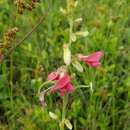Comprehensive Description
provided by North American Flora
Cracca texana Rydberg, sp. nov
A perennial herb; stem 5-10 dm. high, erect, strict, terete, strigose; leaves 1-1.5 dm. long; stipules lance-subulate, 10-15 mm long; petiole 1-3 cm. long, as well as the rachis grayish-strigose; leaflets 13-19, oblong, elliptic, oblanceolate, or oblong-obovate, 2-4 cm. long, 6-15 mm. wide, acutish to truncate and mucronate at the apex, acute or obtuse at the base, strongly veined, glabrous or nearly so above, grayish-strigose beneath; racemes opposite the leaves, including the peduncles 3-7 dm. long; bracts subulate, 5 mm. long; calyx sparingly pubescent with ascending hairs, the tube 3 mm. long, the lobes lanceolate, acuminate, 2.5-3 mm. long; corolla rose-purple, 15 mm. long; banner broadly obovate; wings obovate with an acute basal auricle; keel-petals semiorbicular, with a small basal auricle; pod 5-6 cm. long, 4 mm. wide, slightly downwardly arcuate, strigulose, S-10-seeded.
Type collected on prairies at Hempstead, Texas, June 1, 1872, Elihu Hall 111 (herb. N. Y. Bot. Gard.).
Distribution: Western Louisiana and eastern Texas; apparently also near Mobile, Alabama
- bibliographic citation
- Per Axel Rydberg. 1919. (ROSALES); FABACEAE; PSORALEAE. North American flora. vol 24(1). New York Botanical Garden, New York, NY
Comprehensive Description
provided by North American Flora
Cracca angustifolia (Featherman) Pennell, Bull. Torrey Club 44: 337. 1917.
Tephrosia hispidula S T. & G. Fl. N. Am. 1: 297. 1838.
Tephnsia angustifolia Featherman, Rep. Bot. Surv. Louisiana 1870: 73. 1871.
A perennial herb, with a woody root; stem 5-10 dm. high, pubescent with more or less ascending hairs, leaves about 1 dm. long; stipules subulate, 5-7 mm. long; petiole 1-2.5 cm long, sparingly pubescent; leaflets 7-15, linear or linear-oblanceolate, obtuse to truncate at the apex, 2.5-4 cm. long, 5-8 mm. wide, glabrous or sparingly hairy above, silky-strigose beneath; racemes slender, lax, including the peduncle 2-5 dm. long; flowers 1 or 2 at each node; calyx hirsute, the tube 3.5 mm. long, the lobes subulate, 3-5 mm. long; corolla 15-20 mm. long; banner broadly obovate; wings obliquely oblanceolate, with an acute basal lobe; pod about 6 cm. long, 5 mm. wide, hirsutulous, 8-10-seeded
Type locality: Pine barrens near Ponehatoula, Louisiana.
Distribution: Alabama, Mississippi, and Louisiana
- bibliographic citation
- Per Axel Rydberg. 1919. (ROSALES); FABACEAE; PSORALEAE. North American flora. vol 24(1). New York Botanical Garden, New York, NY
Physical Description
provided by USDA PLANTS text
Perennial, Herbs, Stems woody below, or from woody crown or caudex, Taproot present, Nodules present, Stems or branches arching, spreading or decumbent, Stems less than 1 m tall, Stems solid, Stems or young twigs sparsely to densely hairy, Stem hairs hispid to villous, Leaves alternate, Leaves petiolate, Stipules inconspicuous, absent, or caducous, Stipules setiform, subulate or acicular, Stipules persistent, Stipules free, Leaves compound, Leaves odd pinnate, Leaf or leaflet margins entire, Leaflets opposite, Leaflets 10-many, Leaves hairy on one or both surfaces, Inflorescences racemes, Inflorescence terminal, Inflorescence leaf-opposed, Bracts conspicuously present, Flowers zygomorphic, Calyx 5-lobed, Calyx hairy, Petals separate, Corolla papilionaceous, Petals clawed, Petals white, Petals red, Banner petal ovoid or obovate, Banner petal suborbicular, broadly rounded, Wing petals narrow, oblanceolate to oblong, Wing petals auriculate, Wing tips obtuse or rounded, Keel petals auriculate, spurred, or gibbous, Keel tips obtuse or rounded, not beaked, Stamens 9-10, Stamens monadelphous, united below, Filaments glabrous, Style terete, St yle sharply bent, Style hairy, Style hairy on one side only, Fruit a legume, Fruit unilocular, Fruit freely dehiscent, Fruit elongate, straight, Fruit exserted from calyx, Valves twisting or coiling after dehiscence, Fruit beaked, Fruit hairy, Fruit 3-10 seeded, Seeds ovoid to rounded in outline, Seed surface smooth, Seeds olive, brown, or black, Seed surface mottled or patchy.
Tephrosia onobrychoides: Brief Summary
provided by wikipedia EN
Tephrosia onobrychoides, commonly called multi-bloom hoary pea, is a species of plant in the pea family that is native to Texas, Louisiana, Arkansas, Oklahoma, Mississippi, and Alabama in the United States of America.
- license
- cc-by-sa-3.0
- copyright
- Wikipedia authors and editors

